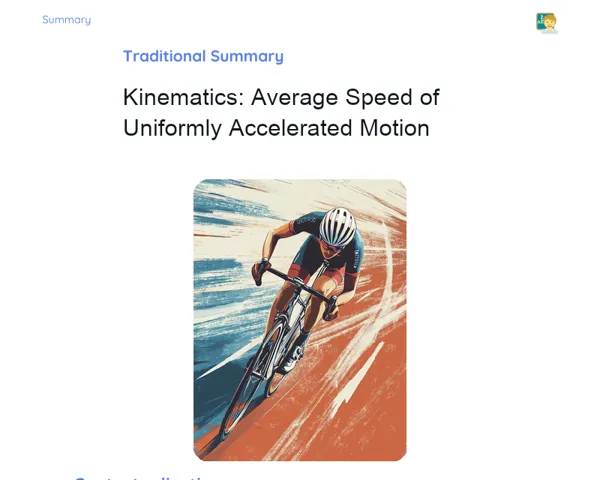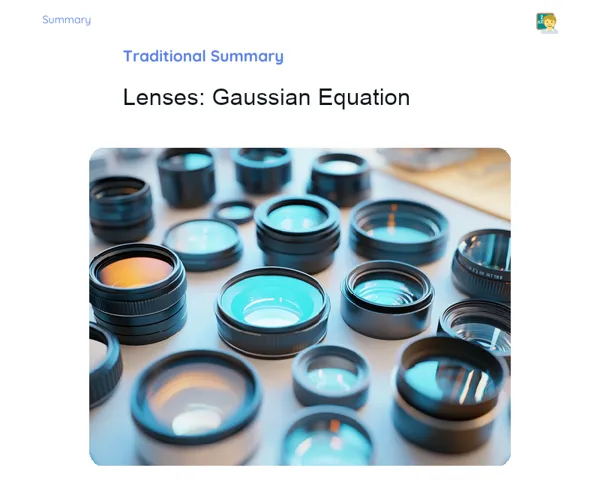Summary Tradisional | Kinematics: Average Vector Acceleration
Contextualization
Acceleration is a vector quantity that tells us how an object's velocity changes with time. In our everyday life, we see acceleration in action when a car speeds up or brakes while moving. This concept is not only fundamental to understanding physical phenomena but is also useful in various fields like engineering, sports, and medicine. For instance, engineers rely on a clear grasp of acceleration when designing vehicles that are both safe and efficient.
In the study of kinematics, it is important to distinguish between average vector acceleration and average scalar acceleration. While the latter only accounts for the change in the magnitude of velocity, average vector acceleration takes both magnitude and direction into account. This difference is particularly important when analysing complex motions, such as circular motion. In a complete lap of circular motion, the overall change in the velocity vector is zero, which means the average vector acceleration is zero. This principle is applied in real-life situations, from tracking the paths of vehicles to understanding the orbits of planets.
To Remember!
Definition of Average Vector Acceleration
Average vector acceleration is defined as the change in an object’s vector velocity divided by the time interval in which that change occurs. Since velocity is a vector (with both magnitude and direction), acceleration too inherits these characteristics. This means that to compute average vector acceleration, we must account for both how fast the object is moving and the way its direction changes over time.
Because it is a vector quantity, average vector acceleration can be graphically represented by an arrow whose length and orientation correspond to the change in vector velocity. This idea is especially useful when examining motions that involve turns or curves, where changes in direction are as important as changes in speed.
A common example is that of a turning car. Even if the speed remains constant during the turn, the continual change in direction results in a non-zero vector acceleration. This makes average vector acceleration a more complete measure of motion than scalar acceleration, which only considers speed.
-
Defined as the change in vector velocity divided by the time interval.
-
Takes into account both the magnitude and the direction of the change in velocity.
-
Can be represented graphically as a vector.
Difference Between Average Vector Acceleration and Average Scalar Acceleration
Average scalar acceleration only measures the change in the magnitude of an object’s velocity, without any reference to its direction. In contrast, average vector acceleration includes both the change in speed and the change in direction. This distinction is key for a proper understanding of motion.
For example, in straight-line motion where the direction remains constant, both types of acceleration can have the same value. However, in scenarios involving curvilinear or circular motion, where directions keep changing, the vector form gives a fuller picture of the motion.
Recognising this difference is crucial when solving problems in physics and engineering, where the direction of motion can significantly influence the outcome of calculations. In a full circle, while the average scalar acceleration might still show a change, the average vector acceleration would be zero since the starting and ending velocity vectors are the same.
-
Scalar acceleration considers only changes in the magnitude of velocity.
-
Vector acceleration considers both the magnitude and the directional changes.
-
Essential for understanding motions that involve curves and circles.
Calculating Average Vector Acceleration
To calculate average vector acceleration, we use the formula a_med = Δv/Δt, where Δv represents the change in the velocity vector and Δt is the time interval over which this change occurs. It is important to remember that Δv is a vector, which means its calculation involves both magnitude and direction.
For instance, consider a car that increases its speed from 20 m/s to 40 m/s over a span of 10 seconds. Here, the change in velocity (Δv) is 20 m/s, and the time interval (Δt) is 10 seconds. By applying the formula, we obtain an average vector acceleration of a_med = 20 m/s / 10 s = 2 m/s². While this calculation is straightforward for straight-line motion, in cases involving curves, the directional change in Δv must also be taken into account.
When the path involves bends or circular trajectories, the situation requires a more detailed vector analysis to accurately determine the average vector acceleration.
-
Use the formula a_med = Δv/Δt.
-
Takes into account both magnitude and direction of Δv.
-
Applies to both straight-line and curved motions.
Vector Acceleration in Circular Motion
In circular motion, average vector acceleration exhibits some unique characteristics. When an object moves along a circular path at a constant speed, the direction of the velocity is continuously changing, even though its magnitude remains constant. However, once the object completes a full circle, the final velocity vector coincides with the initial one, meaning the total change in the velocity vector (Δv) is zero.
This implies that the average vector acceleration over a complete lap is zero. For example, consider a cyclist who completes a lap on a circular track in 60 seconds while maintaining a constant speed. Even though the direction of the cyclist’s velocity is continuously changing, the net change in the velocity vector over the lap is zero, resulting in an average vector acceleration of zero.
This understanding is very helpful when analysing circular motions, such as the movement of planets around the sun or vehicles on roundabouts, as it simplifies the complexity of their trajectories.
-
In circular motion with constant speed, the velocity direction changes continuously.
-
The net change in velocity (Δv) becomes zero after a complete lap.
-
Average vector acceleration is zero over a full lap.
Key Terms
-
Average Vector Acceleration: Change in vector velocity divided by the time interval.
-
Average Scalar Acceleration: Considers only the change in the magnitude of velocity.
-
Δv: Change in vector velocity.
-
Δt: Time interval during which the change in velocity occurs.
-
Circular Motion: Movement along a circular path where the direction of velocity is always changing.
Important Conclusions
In this lesson, we explored the concept of average vector acceleration and highlighted how it differs from average scalar acceleration. We learned that while average scalar acceleration focuses solely on the speed change, average vector acceleration takes into account both the magnitude and the direction of the change in velocity. We also went through the process of calculating average vector acceleration using the formula a_med = Δv/Δt, supporting our understanding with practical examples.
We discussed the additional complexity brought about by changes in direction, especially in curvilinear and circular motions. Notably, in circular motion, although the speed may remain constant, the continuous change in direction results in vector acceleration, which eventually sums up to zero after a full lap. This insight is crucial for analysing complex trajectories, and it finds application in various sectors, from designing safe roadways to studying celestial motions.
A clear understanding of average vector acceleration not only strengthens our grasp of physical concepts but also equips students to tackle real-world problems involving complex motion.
Study Tips
-
Revisit the practical examples discussed during class and try solving additional problems on calculating average vector acceleration.
-
Study circular and curvilinear motions in more depth, focusing on the impact of directional changes in velocity.
-
Explore more resources such as videos and interactive simulations to better visualise the distinctions between vector and scalar acceleration.



